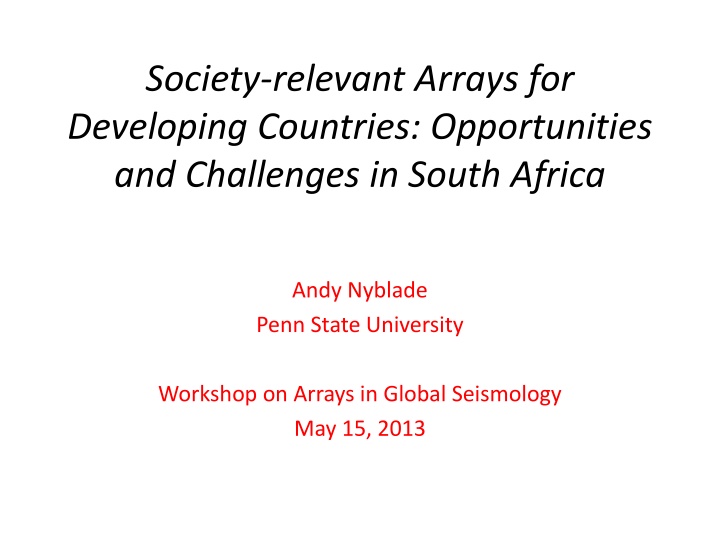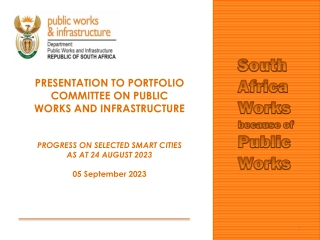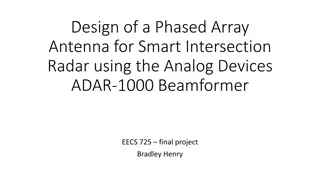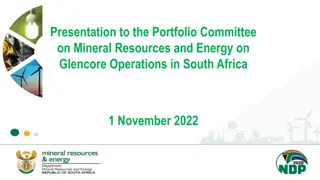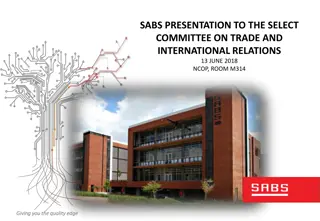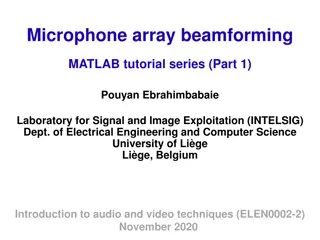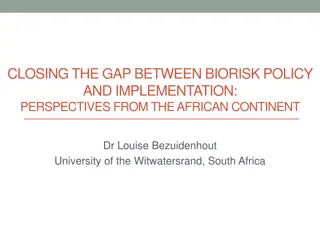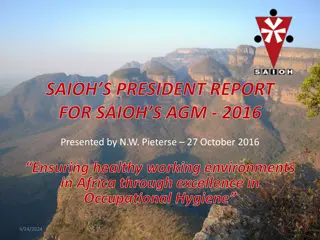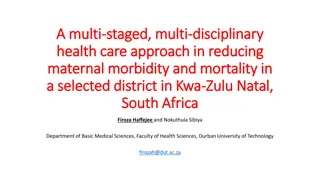Opportunities and Challenges in South Africa's Array Development
South Africa faces the opportunity and challenge of array development for seismic monitoring, as seen in projects like the Niger Array and plans for the Square Kilometre Array. These initiatives involve collaboration with global partners and local communities to enhance detection capabilities, leverage government support, and build multi-use science arrays. The South African National Seismic Network plays a crucial role by contributing data and utilizing advanced technologies like broadband sensors and cell modem telemetry. These efforts highlight the country's engagement in seismology, earth science, and big science projects, positioning it as a key player in array development for societal relevance.
Download Presentation

Please find below an Image/Link to download the presentation.
The content on the website is provided AS IS for your information and personal use only. It may not be sold, licensed, or shared on other websites without obtaining consent from the author.If you encounter any issues during the download, it is possible that the publisher has removed the file from their server.
You are allowed to download the files provided on this website for personal or commercial use, subject to the condition that they are used lawfully. All files are the property of their respective owners.
The content on the website is provided AS IS for your information and personal use only. It may not be sold, licensed, or shared on other websites without obtaining consent from the author.
E N D
Presentation Transcript
Society-relevant Arrays for Developing Countries: Opportunities and Challenges in South Africa Andy Nyblade Penn State University Workshop on Arrays in Global Seismology May 15, 2013
Two models: Largely externally driven - Niger Array (CTBTO) Developed in partnership with the local science community South Africa
Niger Array Comprehensive Nuclear Test-Ban Treaty Organization (CTBTO) sixteen element broadband seismic array in southwestern Niger array has a diameter of 6 km (three rings with a central element), contains twelve vertical and four 3-component broadband sensors (Guralp CMG-3TB) elements have seismic noise characteristics at or below Peterson's Low Noise Model at greater than 0.5 Hz. All of the sensors are emplaced in 50 m boreholes in crystalline rock. The array is capable of resolving and detecting events with magnitude (mb) less than 3.0 from events in Peru and Indonesia, showing that the array significantly adds to the IMS detection capabilities in the Africa region and world-wide.
South Africa a possible different model Engaged seismology and earth science communities Network infrastructure for leveraging Government keen on supporting BIG science Opportunities for building a multi-use science array
Square Kilometre Array An array of dish receptors will extend into eight African countries from a central core region in the Karoo desert of South Africa. A further array of mid frequency aperture arrays will also be built in the Karoo. A smaller array of dish receptors and an array of low frequency aperture arrays will be located in the Murchison Radio-astronomy Observatory in Western Australia. The target construction cost is 1,500 million and construction is scheduled to start in 2016.
South African National Seismic Network Council for Geoscience BB stations Cell modem telemetry Contribute data to: IOTWS AfricaArray (IRIS/DMC)
James et al., 2001 Kgaswane et al., 2012
Mulibo and Nyblade, G- Cubed in press; Mulibo and Nyblade, submitted Hansen et al., EPSL, 2013
South Africa Large Aperture Array PROS: Engaged seismology and earth science communities Network infrastructure for leveraging Government keen on supporting BIG science In kind and real $ support possible Opportunities for building a multi-use science array Mine safety mining related seismicity Natural resource benefits imaging shallow crustal structure of the Bushveld Crust and upper mantle studies linked to the Bushveld Array seismology for Superplume imaging and other targets CONS: Some stations in urban areas. Noise levels may not be optimal at some stations or uniform across the array
If: The Square Kilometre Array: Exploring the Universe with the world's largest radio telescope 1.5B Euro!
Then why not: The 500 Square Kilometre Array: Exploring the planet with the world s largest terrascope $0.X B ??
